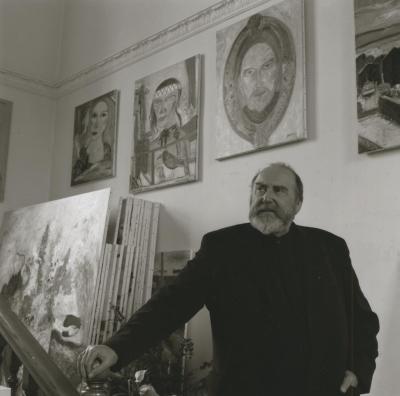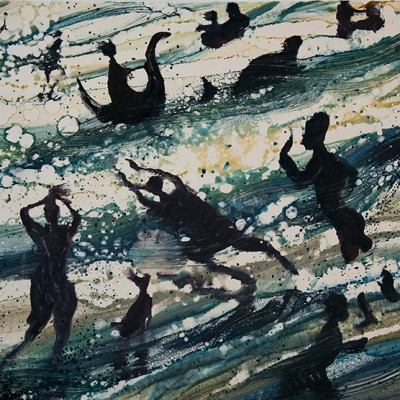Artist of the month: April 2015
Artist of the month: April 2015
George Stubbs ARA
By The RA Collections Team
Published 1 April 2015
Today, George Stubbs ARA is best known as a painter of horses. His depictions of famous racehorses and the English sporting and country life have established him as one of the eminent British painters of the eighteenth-century.
-
Stubbs was born in Liverpool and worked in his father’s currier’s shop until the age of sixteen, when his father agreed that he could begin training as a painter. For a brief period, Stubbs became assistant to Hamlet Wistanley, but he disliked the practice of training by copying other pictures. He soon left Winstanley, “vowing he wou’d for the future look into Nature for himself and consult and study her only”. From then on, he was solely self-trained as an artist, and became extremely proficient in the practices of dissection and anatomical drawing, which underpinned his artistic working methods. Around 1744, Stubbs moved to York to study anatomy at the York County Hospital, where he performed dissections on human bodies and made detailed drawings of his observations. He was soon commissioned by Dr John Burton to design the illustrations for Burton’s new book on midwifery, An Essay Towards a Complete new System of Midwifery, Theoretical and Practical. Despite lacking formal training in printmaking, Stubbs etched the plates for the illustrations himself, using makeshift tools.
Sometime in 1754, Stubbs made a trip to Italy, as was common for British artists in the eighteenth-century. However, unlike his contemporaries, Stubbs remained resolutely unmoved by the art and architecture he saw while in Rome. There is no evidence that he kept a sketchbook while there and it appears his early promise to never copy from the work of other artists extended even to the great works of Roman antiquity and the Renaissance, remaining faithful to his insistence on observing and drawing from nature only. However, it appears that at least one antique sculpture may have proved the exception, the pre-Hellenistic Lion and Horse group. This sculpture was well-known at the time and Stubbs was likely to have seen images of it reproduced in paintings and engravings before his visit to Rome. Stubbs did not directly copy from this sculpture, but rather used its idea - the dramatic impression of the meeting and reaction between two powerful wild animals - combined with his in-depth knowledge of animal anatomy and natural behaviour - to inspire a series of works concerning this theme of the encounter between horse and lion. His engraving A Horse affrighted by a Lion (pictured) is perhaps the best known and most powerful image in his treatment of the theme.
From the 1750s onwards, Stubbs’ sole ambition was to create and publish a complete anatomy of the horse. Before Stubbs, no detailed publication on the anatomy of the horse existed except for Carlo Ruini’s Dell Anatomia et dell’ Infirmita del Cavallo (1598), published more than 160 years previously.
Stubbs’ The Anatomy of the Horse continues to influence artists today, most recently shown in the new commission for the Fourth Plinth in Trafalgar Square. Gift Horse by Hans Haacke, unveiled on 5 March 2015, depicts the skeleton of a horse in mid-motion and is derived from Stubbs’ anatomical etchings. A ribbon displaying the live ticker of the London Stock Exchange is tied to the horse’s raised front leg, inviting questions about the relationship between money, power and the market.
-

W. Nicholls after Ozias Humphry RA, Portrait of George Stubbs ARA, 1809.
Stipple and line engraving. © Royal Academy of Arts, London.
-
Stubbs spent eighteen months at a farmhouse in the village of Horkstow, where he dissected and researched several horses. He worked on each specimen one by one, suspending them from a rig attached to the ceiling constructed from tackle, in which he could position the horses’ bodies to imitate a natural stance. Stubbs made drawings at each stage of dissection, and used them as a basis to make plates for his publication The Anatomy of the Horse, published in 1766. Stubbs etched the plates himself and wrote the text of this study, establishing himself as an anatomist acknowledged throughout Europe. Forty-two of the original drawings survive and were bequeathed to the Royal Academy by Charles Landseer RA. A selection of the drawings were initially put on public display in the staircase leading to the Diploma Galleries, before being moved to the Library to be used as teaching aids for the students.
Stubbs’ studies not only demonstrate his detailed understanding and knowledge of horse anatomy but are also rendered in a sympathetic way, depicting the horse in postures that emulate their natural movement, rather than as clinical cadavers.
Stubbs soon established himself as a portrait painter of the horses of noblemen and gentlemen, gaining lucrative commissions from depicting racing horses, their jockeys and handlers. He also painted studies from wild and exotic animals and from about 1769, began to experiment in painting with enamel on copper, and later ceramic tablets. He devoted himself to developing his own enamel colours, perfecting the preparation and methods needed for this complex technique. The advantage of enamel painting was its durability and permanant appearance, and Stubbs used this to create lasting works of his most famous images. In 1775 he painted his largest enamel on copper, Phaeton attempting to drive the Horses of the Sun, which was also his only mythological depiction of a horse. In his portrait by Ozias Humphry, Stubbs is depicted proudly gesturing towards this copper, although Humphry has painted it on a much larger scale (pictured).
Stubbs was elected ARA in 1780 and a full RA the following year but the latter was annulled after he refused to present a Diploma work.
-

George Stubbs ARA, Finished study for 'The Second Anatomical Table of the Skeleton of the Horse', 1756-1758.

George Stubbs ARA, Finished study for 'The Seventh Anatomical Table of Muscles... of the Horse', 1756-1758.

George Stubbs ARA, Finished study for ‘The Seventh Anatomical Table of the Muscles … of the Horse’, 1756-1758.
-
Find out more about the work of George Stubbs RA in the RA Collection.
The object of the month is A.K. Lawrence’s 1938 painting of the mythical figure of Persephone.







